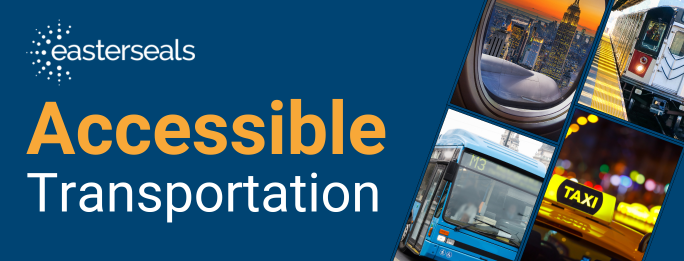Accessible Transportation: A Lifeline to Connect Individuals to Their Communities
by Blog Writers

By Andrea Jennings
Accessible transportation serves as the lifeline for many individuals, fostering connections to communities, enabling access to essential services, and promoting independence. We will explore the impact of an accessible transportation process for all and the importance of accessible design in transportation services, from booking transportation, accessible drop-off and pick-up locations, and seamless connections to arriving at destinations with undamaged mobility aids.
The Seamless Transition: A Personal Anecdote
 As someone who uses multiple mobility aids, I have experienced the impact of navigating different modes of transportation with different mobility aids. I use leg braces, canes, and walkers, depending on my muscle weakness and fatigue level. I often use a wheelchair for traveling as it preserves my energy and reduces my risk of falling. I vividly recall a journey emphasizing the importance of an accessible, seamless transition for transportation. On my way to an essential conference in my industry to connect me to my peers and the community, I faced barriers due to a lack of communication between the transportation company’s staff members.
As someone who uses multiple mobility aids, I have experienced the impact of navigating different modes of transportation with different mobility aids. I use leg braces, canes, and walkers, depending on my muscle weakness and fatigue level. I often use a wheelchair for traveling as it preserves my energy and reduces my risk of falling. I vividly recall a journey emphasizing the importance of an accessible, seamless transition for transportation. On my way to an essential conference in my industry to connect me to my peers and the community, I faced barriers due to a lack of communication between the transportation company’s staff members.
Boarding the train, my intended mode of transportation for that day, was accessible, but connecting to a bus ride through that carrier posed potential barriers. Once I exited the train to transfer to the bus, I could not find any clear instructions or signage to tell me where I could safely wait for the connecting bus and where the bus would arrive. If it had not been for my personal care attendant, who could track down staff members eventually, I might have missed the bus. I should have been able to travel independently with accessibility procedures integrated into the process of transferring from the same carrier’s train to their bus connection. This process could be more seamless, benefiting everyone. This is a great time to mention that hiring persons with lived experience in leadership positions as executives is essential to ensure that different perspectives are included when planning or restructuring designs. Accessible transportation ensures that individuals can move from one mode to another effortlessly and facilitates a sense of connection within the community.
Time Constraints and Accessible Share Rides
A colleague and friend, project manager Ushonda Wilson, highlighted a significant issue within accessible share rides – time constraints. Ushonda explained that she had to leave a work-related community event early because her mode of transportation, which included a train and a ride-share service, only ensured accessible services up to a specific time of day. Time restraints create barriers because Ushonda was excluded from full participation in an important work-community and career-enhancing event. While some of these ride-share services are cost effective, these services often impose strict time limits, hindering individuals with disabilities from thoroughly enjoying community or career-related events. By shedding light on these limitations, we can advocate for more flexible and inclusive policies allowing everyone to travel to work and participate in community activities without undue restrictions.
Drop-Off and Pick-Up Stations: Signage is Essential
Ride-share services play a pivotal role in accessible transportation. Well-defined drop-off and pick-up stations make a significant difference in the effectiveness of these services. Clear signage ensures that designated areas highlight and promote a smooth, accessible, stress-free travel experience.
Shelter and Safety While Waiting
While waiting for transportation, shelter and safety provisions are integral to the transportation experience. Covered waiting areas protect from the elements, ensuring that rain or harsh weather conditions do not become barriers to accessibility. Again, this is a feature everyone can benefit from; extreme weather conditions aggravate many disabilities. By addressing these concerns, we create an environment that prioritizes the well-being of all passengers.
Training Staff on Accessibility Measures: Understanding Disability Etiquette

A key aspect of accessible transportation is ensuring that the drivers and the entire staff, internally and externally, are well trained to address accessibility measures successfully and adequately assist individuals with disabilities. This training should encompass awareness of different disabilities, sensitivity to diverse access requirements as we are not a monolith, and the ability to identify and support passengers requiring additional assistance beyond compliance. Design improvements that allow us to stay in or use our mobility aids or provide the proper storage of our mobility aids while on board is crucial. There are too many instances where mobility aids have been damaged during travel. These changes not only affect our connection to the community because we fear traveling due to the concern of our mobility aids being damaged, but this affects our health and can be a matter of life and death, as it did in the case of Disability advocate Engracia Figueroa. By doing so, transportation providers create a more accessible and inclusive experience for all.
Contingency Plans for Transportation Companies
Contingency plans are essential in the realm of accessible transportation. Companies should establish protocols for unexpected situations, ensuring that individuals with disabilities are not left stranded or facing undue difficulties. A solution is to address unforeseen challenges such as vehicle breakdowns, road closures, or any other disruptions that may impact the smooth operation of services. Also, disseminate these contingency plans in an accessible format in plain language for all to comprehend.
Well-Trained Staff Across Industries
In addition to transportation companies, various industries play a role in ensuring accessibility. Hotels offering shuttle services, public transportation agencies, and other service providers must invest in training their staff on properly addressing and integrating accessibility throughout their company’s infrastructure. This approach extends the principles of accessible transportation beyond the vehicles themselves, creating a holistic and supportive environment for all.
Connecting to Employment and Essential Services
Accessible transportation is not merely about convenience; it is a gateway to employment opportunities and essential services. For many individuals with disabilities, reliable transportation is the key to accessing workplaces, medical facilities, and educational institutions. By highlighting the role of accessible transportation in connecting people to these vital aspects of life, we underscore its broader societal impact.
Universal Design and Human-Centered Design for Inclusive Transportation
 A universal design approach to accessible transportation benefits society as a whole. Ramps, wider aisles, and other accessibility features make transportation more human centered and user friendly for all, including parents with strollers, aging adults, and individuals with temporary injuries. Embracing universal design principles enhances the overall accessibility of transportation systems and reinforces the idea that inclusivity benefits everyone.
A universal design approach to accessible transportation benefits society as a whole. Ramps, wider aisles, and other accessibility features make transportation more human centered and user friendly for all, including parents with strollers, aging adults, and individuals with temporary injuries. Embracing universal design principles enhances the overall accessibility of transportation systems and reinforces the idea that inclusivity benefits everyone.
Promoting Independence Through Accessible Transportation
Perhaps the most profound impact of accessible transportation is the independence it provides. By removing barriers to mobility, these services empower everyone to lead more fulfilling lives, participate actively in their communities, and pursue opportunities that were previously out of reach. Accessible transportation is a service and a catalyst for our future, prioritizing accessibility and serving all communities.
Conclusion
As we work towards a more accessible future, let us recognize how accessible transportation is vital in enriching lives and strengthening the bonds within every community. Accessible transportation is not just a means of getting from point A to point B; it is the lifeline that connects individuals to their communities.
By prioritizing accessible design in all aspects of transportation, from the moment a person books their travel to the moment they arrive at their destination, we can create an accessible and inclusive transportation system that helps all connect to their communities.
The journey toward accessibility requires ongoing collaboration, communication, and a commitment to creating a more connected, inclusive, and accessible society.
 Andrea Jennings, M.Mus., is a Disability & Accessibility Strategist, Actress, and filmmaker passionate about music, law, and entertainment. Her journey led to creating Shifting Creative Paradigms – Leveling The Playing Field® Multi-Media Production Co., advocating for social justice through Disability culture, film, music, and art. Her work has graced prestigious platforms like Park Avenue Armory, The Metropolitan Museum of Art, and Rutgers University. Her work is also recognized in Forbes, Billboard Magazine, The Atlantic Magazine, The Hollywood Reporter, and The New York Times.
Andrea Jennings, M.Mus., is a Disability & Accessibility Strategist, Actress, and filmmaker passionate about music, law, and entertainment. Her journey led to creating Shifting Creative Paradigms – Leveling The Playing Field® Multi-Media Production Co., advocating for social justice through Disability culture, film, music, and art. Her work has graced prestigious platforms like Park Avenue Armory, The Metropolitan Museum of Art, and Rutgers University. Her work is also recognized in Forbes, Billboard Magazine, The Atlantic Magazine, The Hollywood Reporter, and The New York Times.






